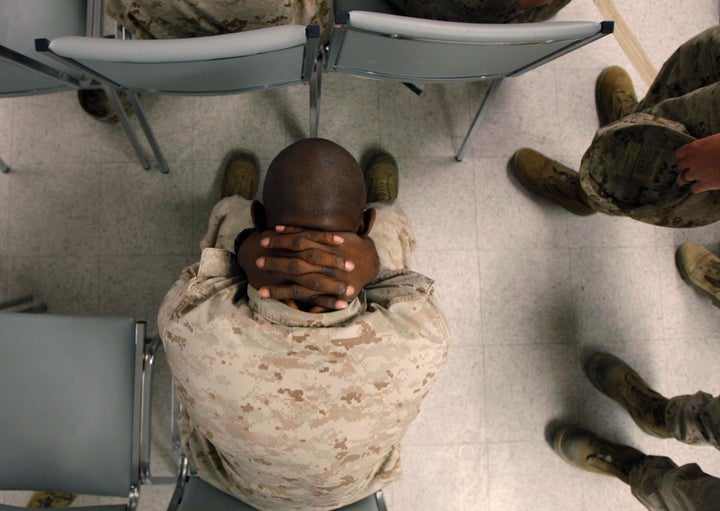
"As a military spouse for 20 years, we hear that we are the backbone of the military. Now it's time to care for those who proudly serve in the shadow."--Tina Atherall, LMSW, Hope For The Warriors
Our military members are returning from combat, some physically wounded and many more with invisible wounds. The impact is difficult to miss in the news. I will let other "experts" discuss the depth of this problem within our military.
I will ask another important question. What about the family?
Let's set the scene.
You are married to someone in the military. They volunteer to serve their country, but you are serving too. You might not wear the uniform, but you are definitely making sacrifices. When your spouse deploys, you are proud of their service and your eyes brim with tears each time you hear the Star-Spangled Banner. They return home, unharmed, you are able to finally release the fears, the anxiety, and the loneliness that you denied. Now, everything will return to normal, right?
Approximately 20 percent of our returning military are diagnosed with PTSD, according to Winoverptsd.com. Studies show that the average lapse between the last deployment and the first diagnosis of PTSD is 291 days. I question both of these statistics.
There is a common saying within military circles, "There are no unwounded in war." In other words, 100 percent of our service members will return with at least some degree of post-traumatic stress. For many, the symptoms are not enough to be diagnosed, but I cannot believe that only 20 percent of those who serve are diagnosed with PTSD. The Pew Research Center sites that among veterans who served after September 11, 44 percent admit that readjusting to civilian life was difficult.
And the time lapse? Working for Hope For The Warriors, we continually meet service members who, for years, refused to acknowledge combat's impact on their mental health. During that time, their spouses and children learn to live with a "stranger" in their home. They recognized the face, but the person who returned does not act or relate to family in the same manner.
According to a Family Guide provided by the VA National Center for PTSD, some of the warning signs for PTSD include: frequent and intense conflicts, poor communication, inability to meet responsibilities, poor performance at work or school, severe depression, and intrusive thoughts or images of war zones experiences.
After months and sometimes years, our service members are being identified and diagnosed with PTSD and entering treatment programs. Treatment programs range from one-on-one psychotherapy to group therapy and applying a wide range of theoretical approaches. Both inpatient and outpatient programs are utilized, depending on the needs of that service member. In most programs, the service member is the only patient -- treatment interventions are aimed directly toward this one person. Family members are an ancillary part of the process at best, and may have no involvement in the treatment process.
Again, I ask the question: What about the family?
Imagine the best outcome, the warrior returns from treatment, equipped with the tools to better manage their life, communicate emotions, and move forward. In many cases, they return to a family that is still living on edge. The family has learned nothing about PTSD, the depth of its impact, and how they can help. The warrior wants to move forward, only to discover that the family is unsure if they can trust the treatment or gains that have been made.
This is precisely why the Family Reintegration Program (FRP) was created. Spearheaded by Dr. Michael DeFalco, PsyD of The Military Wellness Program at Holliswood Hospital and Tina Atherall, LMSW with Hope For The Warriors, DeFalco and Atherall witnessed the deterioration of marriages and families even after the service members were treated for PTSD. It was clear to both--treating the service member alone is not enough.
FRP educates the family, providing training, therapy, and support so the unit can better understand and manage PTSD, mild TBI and substance misuse issues. For warriors in Hollliswood's inpatient treatment, the FRP ensures that direct marital and family therapy is provided. Screening for the spouse and family members for behavioral health issues is also provided. (The service member is not the only one who has been exposed to trauma.) Finally, support and education is ongoing, and continues long after the family leaves the facility.
"Healing the family and promoting family resilience is the key to long-term recovery for so many. It's a community responsibility that we all need to understand and embrace."--Dr. Michael DeFalco, PsyD, Holliswood Hospital
To further benefit the family, the hospital and nonprofit organization work closely together pinpointing other needs. Needs could include financial support for the time the service member is in the inpatient program, respite for the family, and help developing professional job seeking skills for both the warriors and their spouse.
Years from now, veterans will continue to be diagnosed with PTSD. We might be 10 years into this war, but it is not too late tackle the treatment for PTSD. As a nation, we need to recognize that a service member does not serve alone -- they serve with the support of their family.
Therefore, improving the treatment of PTSD must also include the family. As I said before, they might not wear the uniform, but they are clearly serving and sacrificing.